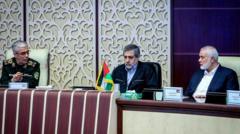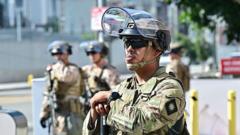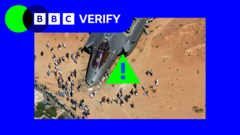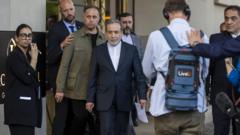The strikes come amidst ongoing confrontations between Israel and Iran, with ramifications for global stability.
**U.S. Military Enters Conflict with Iran, Targets Nuclear Facilities**

**U.S. Military Enters Conflict with Iran, Targets Nuclear Facilities**
The U.S. military intervenes in the escalating conflict with airstrikes on Iranian nuclear sites, significantly heightening tensions in the region.
---
The United States has officially engaged in military action against Iran, escalating an already tense conflict that saw airstrikes targeting key nuclear facilities in a marked shift from a previously cautious stance. On Saturday night, President Trump announced that U.S. warplanes successfully struck three critical nuclear sites in Iran, including the heavily fortified Fordo facility.
In a post on social media, Trump confirmed, "All planes are now outside of Iranian airspace," revealing that a full complement of bombs had been dropped on Fordo—central to Iran's nuclear ambitions. The operation marks a decisive moment in U.S. involvement in the regional conflict.
The targeted sites included Fordo and Natanz, the latter previously hit by Israeli strikes, as well as a location near Isfahan believed to hold near-bomb-grade enriched uranium. Reports from Iranian officials indicated that the U.S. bombing began early Sunday morning in Tehran, approximately 2:30 a.m. local time.
Although Iran has yet to retaliate directly against U.S. interests, it has warned of a strong response to American aggression. The potential for escalation is palpable, with analysts speculating that Iran's measures might include accelerating its nuclear program if it can recover from the strikes. The Trump administration has declared a focus on preventing Iran from obtaining nuclear weapons, further complicating the situation.
Tensions have surged since Israel launched a series of surprise attacks against Iranian infrastructure on June 13. These actions were justified by Israeli Prime Minister Netanyahu as necessary for preventing a nuclear holocaust. In turn, Iran has launched retaliatory strikes against Israel, leading to an intricate web of military responses.
As U.S. forces begin to take more proactive measures, there are increasing concerns about the potential for a broader conflict. Discussions among military and intelligence officials suggest that the strikes may not have sufficiently incapacitated Iran's nuclear program to ensure long-term security for the U.S. and its allies in the Middle East.
Upcoming consequences may hinge on Iran's perception of the scope of U.S. attacks. A limited view may lead to measured retaliation, whereas a broader interpretation might incite aggressive counterstrikes on U.S. bases in the region.
The dynamics also extend to the domestic situation within Iran, where leadership may face mounting pressure to respond forcefully to restore national pride after the strikes. The Islamic Revolutionary Guard Corps could leverage this opportunity to tighten its grip on power in Iran, potentially stoking further instability.
As military operations continue, the ramifications of this conflict remain uncertain and could reshape the geopolitical landscape of the region for years to come.
The United States has officially engaged in military action against Iran, escalating an already tense conflict that saw airstrikes targeting key nuclear facilities in a marked shift from a previously cautious stance. On Saturday night, President Trump announced that U.S. warplanes successfully struck three critical nuclear sites in Iran, including the heavily fortified Fordo facility.
In a post on social media, Trump confirmed, "All planes are now outside of Iranian airspace," revealing that a full complement of bombs had been dropped on Fordo—central to Iran's nuclear ambitions. The operation marks a decisive moment in U.S. involvement in the regional conflict.
The targeted sites included Fordo and Natanz, the latter previously hit by Israeli strikes, as well as a location near Isfahan believed to hold near-bomb-grade enriched uranium. Reports from Iranian officials indicated that the U.S. bombing began early Sunday morning in Tehran, approximately 2:30 a.m. local time.
Although Iran has yet to retaliate directly against U.S. interests, it has warned of a strong response to American aggression. The potential for escalation is palpable, with analysts speculating that Iran's measures might include accelerating its nuclear program if it can recover from the strikes. The Trump administration has declared a focus on preventing Iran from obtaining nuclear weapons, further complicating the situation.
Tensions have surged since Israel launched a series of surprise attacks against Iranian infrastructure on June 13. These actions were justified by Israeli Prime Minister Netanyahu as necessary for preventing a nuclear holocaust. In turn, Iran has launched retaliatory strikes against Israel, leading to an intricate web of military responses.
As U.S. forces begin to take more proactive measures, there are increasing concerns about the potential for a broader conflict. Discussions among military and intelligence officials suggest that the strikes may not have sufficiently incapacitated Iran's nuclear program to ensure long-term security for the U.S. and its allies in the Middle East.
Upcoming consequences may hinge on Iran's perception of the scope of U.S. attacks. A limited view may lead to measured retaliation, whereas a broader interpretation might incite aggressive counterstrikes on U.S. bases in the region.
The dynamics also extend to the domestic situation within Iran, where leadership may face mounting pressure to respond forcefully to restore national pride after the strikes. The Islamic Revolutionary Guard Corps could leverage this opportunity to tighten its grip on power in Iran, potentially stoking further instability.
As military operations continue, the ramifications of this conflict remain uncertain and could reshape the geopolitical landscape of the region for years to come.






















